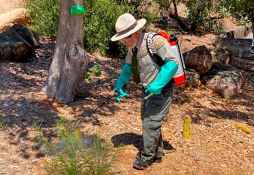Learn about current park closures and updates.
Learn about current park closures and updates.



Invasive species are plants, fungi or animals that are not native to a specific location. They disrupt the local ecosystem, changing processes that have been in play for decades – many causing harm to the areas they invade.
View the
Integrated
Pest Management Plan or read Pests,
Interrupted to learn more about the characteristics
of, and damage incurred by, invasive species.
There are many invasive species in San Diego, and several that have caused considerable harm to local parks. Examples of plants include Yellow Star Thistle, Canary Island St. John’s Wart and Fennel. The Invasive Weed Watch web page managed by the County’s Department of Agriculture, Weights and Measures is also a good source of information. Examples of insects include the Goldspotted Oak Borer or Shot Hole Borer. Because of their tremendous impact on tree loss within County Parks, we’ve included descriptions of both pests below.
The Shot Hole Borer is a boring beetle that drills into tree trunks and branches, bringing with it a pathogenic fungus along with other fungi that are conducive to establishing and nurturing Shot Hole Borer colonies. The Shot Hole Borer is dark brown or black and very small – measuring 0.05 and 0.1 inches. The holes they bore measure approximately 0.85 mm inches in diameter (about the size of the tip of a ballpoint pen). Pregnant females bore into the tree bark and create galleries in which they can lay eggs. Once the eggs hatch, the larvae eat the fungus – gaining the nutrients they need to enter adulthood in about a month. Mature siblings mate with each other inside these galleries and then leave their host tree to affect others in the area. This activity attacks the tree’s vascular tissue and disrupts water and nutrient flow. The fungus that is produced is also harmful to the tree.
Shot Hole Borers are known to have attacked more than 200 species of native, exotic and agricultural trees in Southern California and have been found in a number of environments – from urban landscapes to commercial groves, and now native riparian habitats like those within the Tijuana River Valley.
They can crawl as well as fly, and can easily spread to new locations via dead tree limbs that fall into waterways to be washed downstream. Another mode of transportation is through infected wood, such as firewood being moved from one place to another. For this reason, all County campgrounds require firewood to be purchased in park, so infected wood is not introduced.
Watch the video for additional information, or view our latest FAQ sheet.
Gold Spotted Oak Borer larvae feed beneath the bark of certain oaks near the interface of the phloem and xylem, the nutrient and water conducting tissues of plants. The larvae damage these tissues as well as the cambium – a unicellular layer between the phloem and xylem that is responsible for the radial growth of the tree. Trees die after several years of injury inflicted by multiple generations of the beetle, causing significant aesthetic, economic, ecological and losses to the region.
A number of County park facilities have been severely impacted by GSOB with the loss of hundreds of oak trees. These impacts affect the regional oak tree population, contributing to their death. All those who value oak trees, whether it is for cultural, environmental or aesthetic purposes, are impacted by the rise in oak tree mortality. Oaks play an important role in the culture of area Native American tribes. A reduction in oak tree population threatens their cultural practices. Loss of oak trees reduces habitat and food supply to wildlife. Dead and dying oak trees create a more dangerous wildfire situation by adding combustible fuel and increasing safety hazards along evacuation routes. Containment of GSOB is necessary to prevent further and farther-reaching impacts.
Get additional information on GSOB.org.